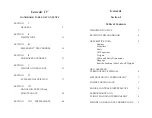
10
We recommend that the first flight with your KOUGAR 2 is made on a
smooth slope or in your usual flying area.
3.3 PREPARATION
For the preparation of the wing, please repeat the method shown on the
chapter 2, Unpacking and Assembly.
Check the condition of the fabric and the lines, making sure there are no
abnormalities. Check the maillons, which attach the lines to the risers are
fully closed. Identify and if necessary disentangle the lines from A, B, and
C risers, the brake lines and the corresponding risers. Check for no ties
or knots.
The correct placement of the wing on the ground prior takeoff is very
important. Select an area free from debris or obstruction and suitable for
the direction of the wind. We recommend placing the wing on the ground
in a semi circular or shoe horse shape.
3.4 FLIGHT PLAN
Draw out a flight plan before take-off in order to avoid possible flight
errors.
3.5 PRE-FLIGHT CHECK LIST
Again we remind all pilots that this manual offers all the necessary
information that will familiarise you with the main characteristics of
your new paraglider. Any information, detail or specification relating to
the power source itself must be obtained from the manufacturer of the
paramotor.
Check that the current and future meteorological conditions of the day are
within the parameters of your own flying experience and ability. Secure
your helmet and individually check each of the maillons ensuring they are
all properly and securely closed. Ensure the engine can easily achieve full
thrust, the level of fuel is appropriate for your flight and the rescue system
is secure and unhindered.
Once ready and immediately prior to takeoff a final visual check of the
equipment and all attachments must be carried out. Checking the lines
unwanted knots and that the trimmers are at the correct setting for takeoff.
3.6 WING INFLATION, CONTROL, AND TAKE-OFF
Taking off on Foot or using a Trike the KOUGAR 2 does not require a
different technique for each. The control of the KOUGAR 2 is intuitive
and the wing inflates easily and progressively in a controlled manner.
Any unwanted oscillation or required course correction can easily be
controlled with gentle pilot input
When the decision has been made to takeoff only a short run is required
and the KOUGAR 2 will quickly transform the forward speed and thrust of
the engine into lift. Even with the Trike only a very short rolling distance is
required to achieve the desired forward lift speed of 25 km/h and take off.
The KOUGAR 2 has been designed to easily and efficiently inflate whilst
providing exceptional directional stability without pitching or hanging
back behind the pilot.
Excessive amounts of energy are not required when taking off with the
Kougar, simply set the trimmers to the correct positions (see 2.7) and
gently lift the risers whilst gaining forward momentum. Taking off in nil
wind conditions is not a problem for the KOUGAR 2 .
3.7 LANDING
The new Reflex System Profile (RSP) with the trimmers closed almost
morphs the KOUGAR 2 into a free flight wing allowing a slow approach
speed and the flight to end with the perfect landing. Large areas and
long runs are no longer required. It must be remember that in nil wind
conditions the forward ground speed encountered may be significant and
Содержание Kougar-2
Страница 1: ...USER S MANUAL KOUGAR 2...
Страница 18: ...18 11 3 RISERS PLAN...
Страница 19: ...19 11 4 SUSPENSION PLAN...
Страница 22: ...KOUGAR 2 20 KOUGAR 2 23 22 11 9 CERTIFICATION SPECIMEN TEST...
Страница 23: ...KOUGAR 2 25 KOUGAR 2 28 23...
Страница 24: ...The importance of small details niviuk com...










































